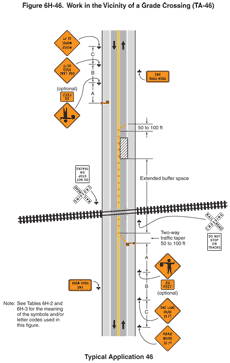|
|
2009 Edition Chapter 6H. Typical Applications
Section 6H.01 Typical Applications
Support:
01 Chapter 6G contains discussions of typical TTC activities. This Chapter presents typical applications for a variety of situations commonly encountered. While not every situation is addressed, the information illustrated can generally be adapted to a broad range of conditions. In many instances, an appropriate TTC plan is achieved by combining features from various typical applications. For example, work at an intersection might present a near-side work zone for one street and a far-side work zone for the other street. These treatments are found in two different typical applications, while a third typical application shows how to handle pedestrian crosswalk closures. For convenience in using the typical application diagrams, Tables 6C-1 and 6C-4 are reproduced in this Chapter as Tables 6H-3 and 6H-4, respectively.
02 Procedures for establishing TTC zones vary with such conditions as road configuration, location of the work, work activity, duration of work, road user volumes, road vehicle mix (buses, trucks, cars, motorcycles, and bicycles), and road user speeds.
03 In general, the procedures illustrated represent minimum solutions for the situations depicted. Except for the notes (which are clearly classified using headings as being Standard, Guidance, Option, or Support), the information presented in the typical applications can generally be regarded as Guidance.
Option:
04 Other devices may be added to supplement the devices and device spacing may be adjusted to provide additional reaction time or delineation. Fewer devices may be used based on field conditions.
Support:
05 Figures and tables found throughout Part 6 provide information for the development of TTC plans. Also, Table 6H-3 is used for the determination of sign spacing and other dimensions for various area and roadway types.
06 Table 6H-1 is an index of the 46 typical applications. Typical applications are shown on the right-hand page with notes on the facing page to the left. The legend for the symbols used in the typical applications is provided in Table 6H-2. In many of the typical applications, sign spacings and other dimensions are indicated by letters using the criteria provided in Table 6H-3. The formulas for determining taper lengths are provided in Table 6H-4.
| Typical Application Description | Typical Application Number |
|---|---|
| Work Outside of the Shoulder (see Section 6G.06) | |
| Work Beyond the Shoulder | TA-1 |
| Blasting Zone | TA-2 |
| Work on the Shoulder (see Sections 6G.07 and 6G.08) | |
| Work on the Shoulders | TA-3 |
| Short Duration or Mobile Operation on a Shoulder | TA-4 |
| Shoulder Closure on a Freeway | TA-5 |
| Shoulder Work with Minor Encroachment | TA-6 |
| Work Within the Traveled Way of a Two-Lane Highway (see Section 6G.10) | |
| Road Closed with a Diversion | TA-7 |
| Roads Closed with an Off-Site Detour | TA-8 |
| Overlapping Routes with a Detour | TA-9 |
| Lane Closure on a Two-Lane Road Using Flaggers | TA-10 |
| Lane Closure on a Two-Lane Road with Low Traffic Volumes | TA-11 |
| Lane Closure on a Two-Lane Road Using Traffic Control Signals | TA-12 |
| Temporary Road Closure | TA-13 |
| Haul Road Crossing | TA-14 |
| Work in the Center of a Road with Low Traffic Volumes | TA-15 |
| Surveying Along the Center Line of a Road with Low Traffic Volumes | TA-16 |
| Mobile Operations on a Two-Lane Road | TA-17 |
| Work Within the Traveled Way of an Urban Street (see Section 6G.11) | |
| Lane Closure on a Minor Street | TA-18 |
| Detour for One Travel Direction | TA-19 |
| Detour for a Closed Street | TA-20 |
| Work Within the Traveled Way at an Intersection and on Sidewalks (see Section 6G.13) | |
| Lane Closure on the Near Side of an Intersection | TA-21 |
| Right-Hand Lane Closure on the Far Side of an Intersection | TA-22 |
| Left-Hand Lane Closure on the Far Side of an Intersection | TA-23 |
| Half Road Closure on the Far Side of an Intersection | TA-24 |
| Multiple Lane Closures at an Intersection | TA-25 |
| Closure in the Center of an Intersection | TA-26 |
| Closure at the Side of an Intersection | TA-27 |
| Sidewalk Detour or Diversion | TA-28 |
| Crosswalk Closures and Pedestrian Detours | TA-29 |
| Work Within the Traveled Way of a Multi-Lane, Non-Access Controlled Highway (see Section 6G.12) | |
| Interior Lane Closure on a Multi-Lane Street | TA-30 |
| Lane Closure on a Street with Uneven Directional Volumes | TA-31 |
| Half Road Closure on a Multi-Lane, High-Speed Highway | TA-32 |
| Stationary Lane Closure on a Divided Highway | TA-33 |
| Lane Closure with a Temporary Traffic Barrier | TA-34 |
| Mobile Operation on a Multi-Lane Road | TA-35 |
| Work Within the Traveled Way of a Freeway or Expressway (see Section 6G.14) | |
| Lane Shift on a Freeway | TA-36 |
| Double Lane Closure on a Freeway | TA-37 |
| Interior Lane Closure on a Freeway | TA-38 |
| Median Crossover on a Freeway | TA-39 |
| Median Crossover for an Entrance Ramp | TA-40 |
| Median Crossover for an Exit Ramp | TA-41 |
| Work in the Vicinity of an Exit Ramp | TA-42 |
| Partial Exit Ramp Closure | TA-43 |
| Work in the Vicinity of an Entrance Ramp | TA-44 |
| Temporary Reversible Lane Using Movable Barriers | TA-45 |
| Work in the Vicinity of a Grade Crossing (see Section 6G.18) | |
| Work in the Vicinity of a Grade Crossing | TA-46 |
| Symbols | Description |
|---|---|
 |
Arrow board |
| Arrow board support or trailer (shown facing down) |
|
| Changeable message sign or support trailer | |
| Channelizing device | |
| Crash cushion | |
| Direction of temporary traffic detour | |
| Direction of traffic | |
| Flagger | |
 |
High-level warning device (Flag tree) |
| Longitudinal channelizing device | |
| Luminaire | |
| Pavement markings that should be removed for a long-term project |
|
| Shadow vehicle | |
| Sign (shown facing left) | |
| Surveyor | |
| Temporary barrier | |
| Temporary barrier with warning light | |
| Traffic or pedestrian signal | |
| Truck-mounted attenuator | |
| Type 3 barricade | |
| Warning light | |
| Work space | |
| Work vehicle |
| Road Type | Distance Between Signs** | ||
|---|---|---|---|
| A | B | C | |
| Urban (low speed)* | 100 feet | 100 feet | 100 feet |
| Urban (high speed)* | 350 feet | 350 feet | 350 feet |
| Rural | 500 feet | 500 feet | 500 feet |
| Expressway / Freeway | 1,000 feet | 1,500 feet | 2,640 feet |
* Speed category to be determined by the highway agency
** The column headings A, B, and C are the dimensions shown in Figures 6H-1 through 6H-46. The A dimension is the distance from the transition or point of restriction to the first sign. The B dimension is the distance between the first and second signs. The C dimension is the distance between the second and third signs. (The "first sign" is the sign in a three-sign series that is closest to the TTC zone. The "third sign" is the sign that is furthest upstream from the TTC zone.)
| Speed (S) | Taper Length (L) in feet |
|---|---|
| 40 mph or less | L = WS2 / 60 |
| 45 mph or more | L = WS |
Where:
- L = taper length in feet
- W = width of offset in feet
- S = posted speed limit, or off-peak 85th-percentile speed prior to work starting, or the anticipated operating speed in mph
07 Most of the typical applications show TTC devices for only one direction.
Notes for Figure 6H-1—Typical Application 1
Work Beyond the Shoulder
Guidance:
- If the work space is in the median of a divided highway, an advance warning sign should also be placed on the left side of the directional roadway.
Option:
- The ROAD WORK AHEAD sign may be replaced with other appropriate signs such as the SHOULDER WORK sign. The SHOULDER WORK sign may be used for work adjacent to the shoulder.
- The ROAD WORK AHEAD sign may be omitted where the work space is behind a barrier, more than 24 inches behind the curb, or 15 feet or more from the edge of any roadway.
- For short-term, short duration or mobile operation, all signs and channelizing devices may be eliminated if a vehicle with activated high-intensity rotating, flashing, oscillating, or strobe lights is used.
- Vehicle hazard warning signals may be used to supplement high-intensity rotating, flashing, oscillating, or strobe lights.
Standard:
- Vehicle hazard warning signals shall not be used instead of the vehicle's high-intensity rotating, flashing, oscillating, or strobe lights.
Figure 6H-1 Work Beyond the Shoulder (TA-1)
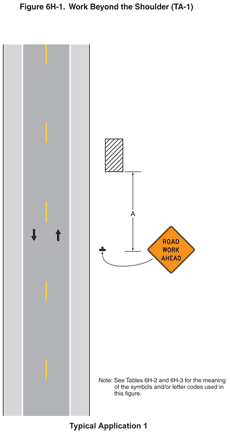
Notes for Figure 6H-2—Typical Application 2
Blasting Zone
Standard:
- Whenever blasting caps are used within 1,000 feet of a roadway, the signing shown shall be used.
- The signs shall be covered or removed when there are no explosives in the area or the area is otherwise secure.
- Whenever a side road intersects the roadway between the BLASTING ZONE AHEAD sign and the END BLASTING ZONE sign, or a side road is within 1,000 feet of any blasting cap, similar signing, as on the mainline, shall be installed on the side road.
- Prior to blasting, the blaster in charge shall determine whether road users in the blasting zone will be endangered by the blasting operation. If there is danger, road users shall not be permitted to pass through the blasting zone during blasting operations.
Guidance:
- On a divided highway, the signs should be mounted on both sides of the directional roadways.
Figure 6H-2 Blasting Zone (TA-2)
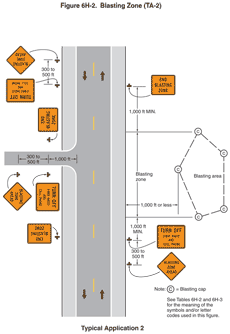
Notes for Figure 6H-3—Typical Application 3
Work on the Shoulders
Guidance:
- A SHOULDER WORK sign should be placed on the left side of the roadway for a divided or one-way street only if the left shoulder is affected.
Option:
- The Workers symbol signs may be used instead of SHOULDER WORK signs.
- The SHOULDER WORK AHEAD sign on an intersecting roadway may be omitted where drivers emerging from that roadway will encounter another advance warning sign prior to this activity area.
- For short duration operations of 60 minutes or less, all signs and channelizing devices may be eliminated if a vehicle with activated high-intensity rotating, flashing, oscillating, or strobe lights is used.
- Vehicle hazard warning signals may be used to supplement high-intensity rotating, flashing, oscillating, or strobe lights.
Standard:
- Vehicle hazard warning signals shall not be used instead of the vehicle's high-intensity rotating, flashing, oscillating, or strobe lights.
- When paved shoulders having a width of 8 feet or more are closed, at least one advance warning sign shall be used. In addition, channelizing devices shall be used to close the shoulder in advance to delineate the beginning of the work space and direct vehicular traffic to remain within the traveled way.
Figure 6H-3 Work on the Shoulders (TA-3)
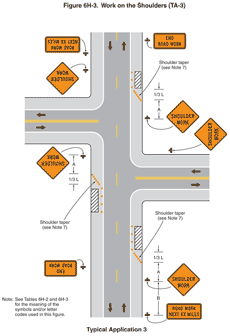
Notes for Figure 6H-4—Typical Application 4
Short Duration or Mobile Operation on a Shoulder
Guidance:
- In those situations where multiple work locations within a limited distance make it practical to place stationary signs, the distance between the advance warning sign and the work should not exceed 5 miles.
- In those situations where the distance between the advance signs and the work is 2 miles to 5 miles, a Supplemental Distance plaque should be used with the ROAD WORK AHEAD sign.
Option:
- The ROAD WORK NEXT XX MILES sign may be used instead of the ROAD WORK AHEAD sign if the work locations occur over a distance of more than 2 miles.
- Stationary warning signs may be omitted for short duration or mobile operations if the work vehicle displays high-intensity rotating, flashing, oscillating, or strobe lights.
- Vehicle hazard warning signals may be used to supplement high-intensity rotating, flashing, oscillating, or strobe lights.
Standard:
- Vehicle hazard warning signals shall not be used instead of the vehicle's high-intensity rotating, flashing, oscillating, or strobe lights.
- If an arrow board is used for an operation on the shoulder, the caution mode shall be used.
- Vehicle-mounted signs shall be mounted in a manner such that they are not obscured by equipment or supplies. Sign legends on vehicle-mounted signs shall be covered or turned from view when work is not in progress.
Figure 6H-4 Short-Duration or Mobile Operation on a Shoulder (TA-4)
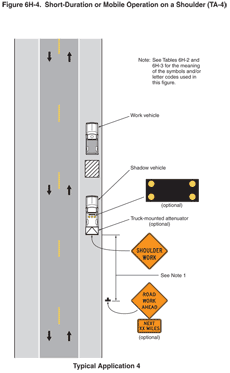
Notes for Figure 6H-5—Typical Application 5
Shoulder Closure on a Freeway
Guidance:
- SHOULDER CLOSED signs should be used on limited-access highways where there is no opportunity for disabled vehicles to pull off the roadway.
- If drivers cannot see a pull-off area beyond the closed shoulder, information regarding the length of the shoulder closure should be provided in feet or miles, as appropriate.
- The use of a temporary traffic barrier should be based on engineering judgment.
Standard:
- Temporary traffic barriers, if used, shall comply with the provisions of Section 6F.85.
Option:
- The barrier shown in this typical application is an example of one method that may be used to close a shoulder of a long-term project.
- The warning lights shown on the barrier may be used.
Figure 6H-5 Shoulder Closure on a Freeway (TA-5)
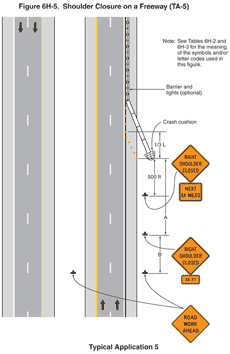
Notes for Figure 6H-6—Typical Application 6
Shoulder Work with Minor Encroachment
Guidance:
- All lanes should be a minimum of 10 feet in width as measured to the near face of the channelizing devices.
- The treatment shown should be used on a minor road having low speeds. For higher-speed traffic conditions, a lane closure should be used.
Option:
- For short-term use on low-volume, low-speed roadways with vehicular traffic that does not include longer and wider heavy commercial vehicles, a minimum lane width of 9 feet may be used.
- Where the opposite shoulder is suitable for carrying vehicular traffic and of adequate width, lanes may be shifted by use of closely-spaced channelizing devices, provided that the minimum lane width of 10 feet is maintained.
- Additional advance warning may be appropriate, such as a ROAD NARROWS sign.
- Temporary traffic barriers may be used along the work space.
- The shadow vehicle may be omitted if a taper and channelizing devices are used.
- A truck-mounted attenuator may be used on the shadow vehicle.
- For short-duration work, the taper and channelizing devices may be omitted if a shadow vehicle with activated high-intensity rotating, flashing, oscillating, or strobe lights is used.
- Vehicle hazard warning signals may be used to supplement high-intensity rotating, flashing, oscillating, or strobe lights.
Standard:
- Vehicle-mounted signs shall be mounted in a manner such that they are not obscured by equipment or supplies. Sign legends on vehicle-mounted signs shall be covered or turned from view when work is not in progress.
- Shadow and work vehicles shall display high-intensity rotating, flashing, oscillating, or strobe lights.
- Vehicle hazard warning signals shall not be used instead of the vehicle's high-intensity rotating, flashing, oscillating, or strobe lights.
Figure 6H-6 Shoulder Work with Minor Encroachment (TA-6)
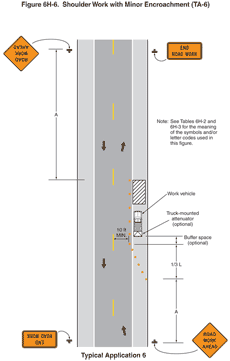
Notes for Figure 6H-7—Typical Application 7
Road Closure with a Diversion
Support:
- Signs and object markers are shown for one direction of travel only.
Standard:
- Devices similar to those depicted shall be placed for the opposite direction of travel.
- Pavement markings no longer applicable to the traffic pattern of the roadway shall be removed or obliterated before any new traffic patterns are open to traffic.
- Temporary barriers and end treatments shall be crashworthy.
Guidance:
- If the tangent distance along the temporary diversion is more than 600 feet, a Reverse Curve sign, left first, should be used instead of the Double Reverse Curve sign, and a second Reverse Curve sign, right first, should be placed in advance of the second reverse curve back to the original alignment.
- When the tangent section of the diversion is more than 600 feet, and the diversion has sharp curves with recommended speeds of 30 mph or less, Reverse Turn signs should be used.
- Where the temporary pavement and old pavement are different colors, the temporary pavement should start on the tangent of the existing pavement and end on the tangent of the existing pavement.
Option:
- Flashing warning lights and/or flags may be used to call attention to the warning signs.
- On sharp curves, large arrow signs may be used in addition to other advance warning signs.
- Delineators or channelizing devices may be used along the diversion.
Figure 6H-7 Road Closure with a Diversion (TA-7)
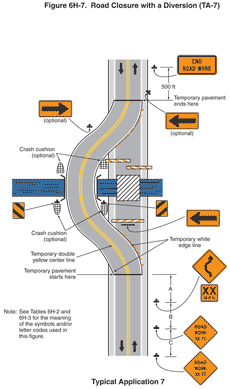
Notes for Figure 6H-8—Typical Application 8
Road Closure with an Off-Site Detour
Guidance:
- Regulatory traffic control devices should be modified as needed for the duration of the detour.
Option:
- If the road is opened for some distance beyond the intersection and/or there are significant origin/destination points beyond the intersection, the ROAD CLOSED and DETOUR signs on Type 3 Barricades may be located at the edge of the traveled way.
- A Route Sign Directional assembly may be placed on the far left corner of the intersection to augment or replace the one shown on the near right corner.
- Flashing warning lights and/or flags may be used to call attention to the advance warning signs.
- Cardinal direction plaques may be used with route signs.
Figure 6H-8 Road Closure with an Off-Site Detour (TA-8)
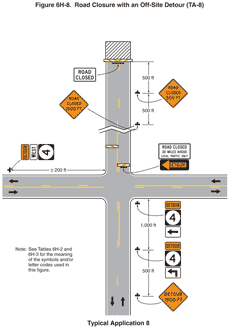
Notes for Figure 6H-9—Typical Application 9
Overlapping Routes with a Detour
Support:
- TTC devices are shown for one direction of travel only.
Standard:
- Devices similar to those depicted shall be placed for the opposite direction of travel.
Guidance:
- STOP or YIELD signs displayed to side roads should be installed as needed along the temporary route.
Option:
- Flashing warning lights and/or flags may be used to call attention to the advance warning signs.
- Flashing warning lights may be used on the Type 3 Barricades.
- Cardinal direction plaques may be used with route signs.
Figure 6H-9 Overlapping Routes with a Detour (TA-9)
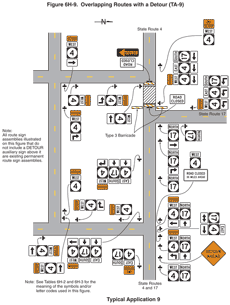
Notes for Figure 6H-10—Typical Application 10
Lane Closure on a Two-Lane Road Using Flaggers
Option:
- For low-volume situations with short work zones on straight roadways where the flagger is visible to road users approaching from both directions, a single flagger, positioned to be visible to road users approaching from both directions, may be used (see Chapter 6E).
- The ROAD WORK AHEAD and the END ROAD WORK signs may be omitted for short-duration operations.
- Flashing warning lights and/or flags may be used to call attention to the advance warning signs. A BE PREPARED TO STOP sign may be added to the sign series.
Guidance:
- The buffer space should be extended so that the two-way traffic taper is placed before a horizontal (or crest vertical) curve to provide adequate sight distance for the flagger and a queue of stopped vehicles.
Standard:
- At night, flagger stations shall be illuminated, except in emergencies.
Guidance:
- When used, the BE PREPARED TO STOP sign should be located between the Flagger sign and the ONE LANE ROAD sign.
- When a grade crossing exists within or upstream of the transition area and it is anticipated that queues resulting from the lane closure might extend through the grade crossing, the TTC zone should be extended so that the transition area precedes the grade crossing.
- When a grade crossing equipped with active warning devices exists within the activity area, provisions should be made for keeping flaggers informed as to the activation status of these warning devices.
- When a grade crossing exists within the activity area, drivers operating on the left-hand side of the normal center line should be provided with comparable warning devices as for drivers operating on the right-hand side of the normal center line.
- Early coordination with the railroad company or light rail transit agency should occur before work starts.
Option:
- A flagger or a uniformed law enforcement officer may be used at the grade crossing to minimize the probability that vehicles are stopped within 15 feet of the grade crossing, measured from both sides of the outside rails.
Figure 6H-10 Lane Closure on a Two-Lane Road Using Flaggers (TA-10)
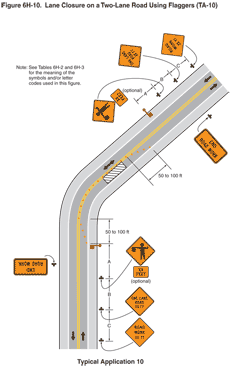
Notes for Figure 6H-11—Typical Application 11
Lane Closure on a Two-Lane Road with Low Traffic Volumes
Option:
- This TTC zone application may be used as an alternate to the TTC application shown in Figure 6H-10 (using flaggers) when the following conditions exist:
- Vehicular traffic volume is such that sufficient gaps exist for vehicular traffic that must yield.
- Road users from both directions are able to see approaching vehicular traffic through and beyond the worksite and have sufficient visibility of approaching vehicles.
- The Type B flashing warning lights may be placed on the ROAD WORK AHEAD and the ONE LANE ROAD AHEAD signs whenever a night lane closure is necessary.
Figure 6H-11 Lane Closure on a Two-Lane Road with Low Traffic Volumes (TA-11)
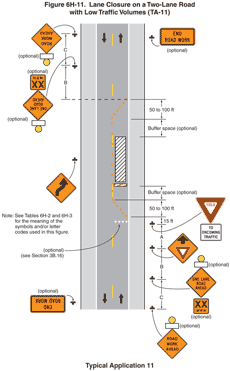
Notes for Figure 6H-12—Typical Application 12
Lane Closure on a Two-Lane Road Using Traffic Control Signals
Standard:
- Temporary traffic control signals shall be installed and operated in accordance with the provisions of Part 4. Temporary traffic control signals shall meet the physical display and operational requirements of conventional traffic control signals.
- Temporary traffic control signal timing shall be established by authorized officials. Durations of red clearance intervals shall be adequate to clear the one-lane section of conflicting vehicles.
- When the temporary traffic control signal is changed to the flashing mode, either manually or automatically, red signal indications shall be flashed to both approaches.
- Stop lines shall be installed with temporary traffic control signals for intermediate and long-term closures. Existing conflicting pavement markings and raised pavement marker reflectors between the activity area and the stop line shall be removed. After the temporary traffic control signal is removed, the stop lines and other temporary pavement markings shall be removed and the permanent pavement markings restored.
- Safeguards shall be incorporated to avoid the possibility of conflicting signal indications at each end of the TTC zone.
Guidance:
- Where no-passing lines are not already in place, they should be added.
- Adjustments in the location of the advance warning signs should be made as needed to accommodate the horizontal or vertical alignment of the roadway, recognizing that the distances shown for sign spacings are minimums. Adjustments in the height of the signal heads should be made as needed to conform to the vertical alignment.
Option:
- Flashing warning lights shown on the ROAD WORK AHEAD and the ONE LANE ROAD AHEAD signs may be used.
- Removable pavement markings may be used.
Support:
- Temporary traffic control signals are preferable to flaggers for long-term projects and other activities that would require flagging at night.
- The maximum length of activity area for one-way operation under temporary traffic control signal control is determined by the capacity required to handle the peak demand.
Figure 6H-12 Lane Closure on a Two-Lane Road Using Traffic Control Signals (TA-12)
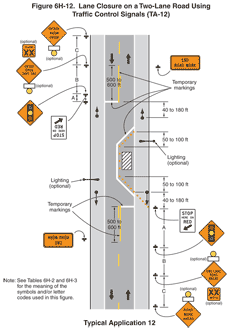
Notes for Figure 6H-13—Typical Application 13
Temporary Road Closure
Support:
- Conditions represented are a planned closure not exceeding 20 minutes during the daytime.
Standard:
- A flagger or uniformed law enforcement officer shall be used for this application. The flagger, if used for this application, shall follow the procedures provided in Sections 6E.07 and 6E.08.
Guidance:
- The uniformed law enforcement officer, if used for this application, should follow the procedures provided in Sections 6E.07 and 6E.08.
Option:
- A BE PREPARED TO STOP sign may be added to the sign series.
Guidance:
- When used, the BE PREPARED TO STOP sign should be located before the Flagger symbol sign.
Figure 6H-13 Temporary Road Closure (TA-13)
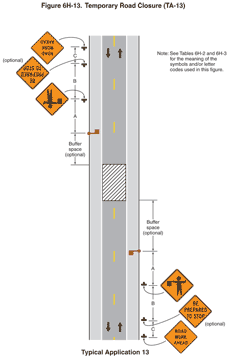
Notes for Figure 6H-14—Typical Application 14
Haul Road Crossing
Guidance:
- Floodlights should be used to illuminate haul road crossings where existing light is inadequate.
- Where no-passing lines are not already in place, they should be added.
Standard:
- The traffic control method selected shall be used in both directions.
Flagging Method
- When a road used exclusively as a haul road is not in use, the haul road shall be closed with Type 3 Barricades and the Flagger symbol signs covered.
- The flagger shall follow the procedures provided in Sections 6E.07 and 6E.08.
- At night, flagger stations shall be illuminated, except in emergencies.
Signalized Method
- When a road used exclusively as a haul road is not in use, the haul road shall be closed with Type 3 Barricades. The signals shall either flash yellow on the main road or be covered, and the Signal Ahead and STOP HERE ON RED signs shall be covered or hidden from view.
- The temporary traffic control signals shall control both the highway and the haul road and shall meet the physical display and operational requirements of conventional traffic control signals as described in Part 4. Traffic control signal timing shall be established by authorized officials.
- Stop lines shall be used on existing highway with temporary traffic control signals.
- Existing conflicting pavements markings between the stop lines shall be removed. After the temporary traffic control signal is removed, the stop lines and other temporary pavement markings shall be removed and the permanent pavement markings restored.
Figure 6H-14 Haul Road Crossing (TA-14)
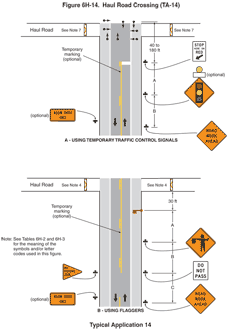
Notes for Figure 6H-15—Typical Application 15
Work in the Center of a Road with Low Traffic Volumes
Guidance:
- The lanes on either side of the center work space should have a minimum width of 10 feet as measured from the near edge of the channelizing devices to the edge of the pavement or the outside edge of the paved shoulder.
Option:
- Flashing warning lights and/or flags may be used to call attention to the advance warning signs.
- If the closure continues overnight, warning lights may be used on the channelizing devices.
- A lane width of 9 feet may be used for short-term stationary work on low-volume, low-speed roadways when motor vehicle traffic does not include longer and wider heavy commercial vehicles.
- A work vehicle displaying high-intensity rotating, flashing, oscillating, or strobe lights may be used instead of the channelizing devices forming the tapers or the high-level warning devices.
- Vehicle hazard warning signals may be used to supplement high-intensity rotating, flashing, oscillating, or strobe lights.
Standard:
- Vehicle hazard warning signals shall not be used instead of the vehicle's high-intensity rotating, flashing, oscillating, or strobe lights.
Figure 6H-15 Work in the Center of a Road with Low Traffic Volumes (TA-15)
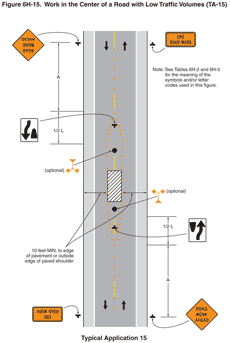
Notes for Figure 6H-16—Typical Application 16
Surveying Along the Center Line of a Road with Low Traffic Volumes
Guidance:
- The lanes on either side of the center work space should have a minimum width of 10 feet as measured from the near edge of the channelizing devices to the edge of the pavement or the outside edge of the paved shoulder.
- Cones should be placed 6 to 12 inches on either side of the center line.
- A flagger should be used to warn workers who cannot watch road users.
Standard:
- For surveying on the center line of a high-volume road, one lane shall be closed using the information illustrated in Figure 6H-10.
Option:
- A high-level warning device may be used to protect a surveying device, such as a target on a tripod.
- Cones may be omitted for a cross-section survey.
- ROAD WORK AHEAD signs may be used in place of the SURVEY CREW AHEAD signs.
- Flags may be used to call attention to the advance warning signs.
- If the work is along the shoulder, the flagger may be omitted.
- For a survey along the edge of the road or along the shoulder, cones may be placed along the edge line.
- A BE PREPARED TO STOP sign may be added to the sign series.
Guidance:
- When used, the BE PREPARED TO STOP sign should be located before the Flagger symbol sign.
Figure 6H-16 Surveying Along the Center Line of a Road with Low Traffic Volumes (TA-16)
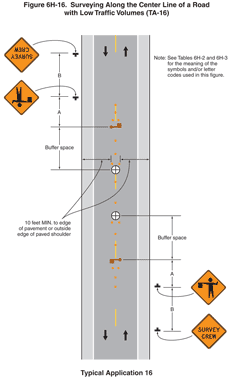
Notes for Figure 6H-17—Typical Application 17
Mobile Operations on a Two-Lane Road
Standard:
- Vehicle-mounted signs shall be mounted in a manner such that they are not obscured by equipment or supplies. Sign legends on vehicle-mounted signs shall be covered or turned from view when work is not in progress.
- Shadow and work vehicles shall display high-intensity rotating, flashing, oscillating, or strobe lights.
- If an arrow board is used, it shall be used in the caution mode.
Guidance:
- Where practical and when needed, the work and shadow vehicles should pull over periodically to allow vehicular traffic to pass.
- Whenever adequate stopping sight distance exists to the rear, the shadow vehicle should maintain the minimum distance from the work vehicle and proceed at the same speed. The shadow vehicle should slow down in advance of vertical or horizontal curves that restrict sight distance.
- The shadow vehicles should also be equipped with two high-intensity flashing lights mounted on the rear, adjacent to the sign.
Option:
- The distance between the work and shadow vehicles may vary according to terrain, paint drying time, and other factors.
- Additional shadow vehicles to warn and reduce the speed of oncoming or opposing vehicular traffic may be used. Law enforcement vehicles may be used for this purpose.
- A truck-mounted attenuator may be used on the shadow vehicle or on the work vehicle.
- If the work and shadow vehicles cannot pull over to allow vehicular traffic to pass frequently, a DO NOT PASS sign may be placed on the rear of the vehicle blocking the lane.
Support:
- Shadow vehicles are used to warn motor vehicle traffic of the operation ahead.
Standard:
- Vehicle hazard warning signals shall not be used instead of the vehicle's high-intensity rotating, flashing, oscillating, or strobe lights.
Figure 6H-17 Mobile Operations on a Two-Lane Road (TA-17)
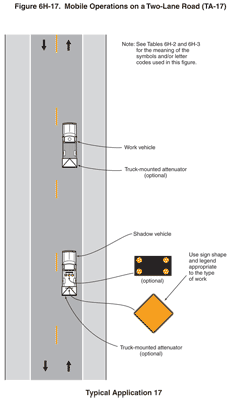
Notes for Figure 6H-18—Typical Application 18
Lane Closure on a Minor Street
Standard:
- This TTC shall be used only for low-speed facilities having low traffic volumes.
Option:
- Where the work space is short, where road users can see the roadway beyond, and where volume is low, vehicular traffic may be self-regulating.
Standard:
- Where vehicular traffic cannot effectively self-regulate, one or two flaggers shall be used as illustrated in Figure 6H-10.
Option:
- Flashing warning lights and/or flags may be used to call attention to the advance warning signs.
- A truck-mounted attenuator may be used on the work vehicle and the shadow vehicle.
Figure 6H-18 Lane Closure on a Minor Street (TA-18)
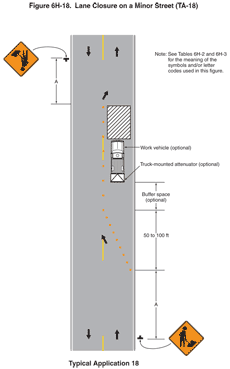
Notes for Figure 6H-19—Typical Application 19
Detour for One Travel Direction
Guidance:
- This plan should be used for streets without posted route numbers.
- On multi-lane streets, Detour signs with an Advance Turn Arrow should be used in advance of a turn.
Option:
- The STREET CLOSED legend may be used in place of ROAD CLOSED.
- Additional DO NOT ENTER signs may be used at intersections with intervening streets.
- Warning lights may be used on Type 3 Barricades.
- Detour signs may be located on the far side of intersections.
- A Street Name sign may be mounted with the Detour sign. The Street Name sign may be either white on green or black on orange.
Standard:
- When used, the Street Name sign shall be placed above the Detour sign.
Figure 6H-19 Detour for One Travel Direction (TA-19)

Notes for Figure 6H-20—Typical Application 20
Detour for a Closed Street
Guidance:
- This plan should be used for streets without posted route numbers.
- On multi-lane streets, Detour signs with an Advance Turn Arrow should be used in advance of a turn.
Option:
- Flashing warning lights and/or flags may be used to call attention to the advance warning signs.
- Flashing warning lights may be used on Type 3 Barricades.
- Detour signs may be located on the far side of intersections. A Detour sign with an advance arrow may be used in advance of a turn.
- A Street Name sign may be mounted with the Detour sign. The Street Name sign may be either white on green or black on orange.
Standard:
- When used, the Street Name sign shall be placed above the Detour sign.
Support:
- See Figure 6H-9 for the information for detouring a numbered highway.
Figure 6H-20 Detour for a Closed Street (TA-20)
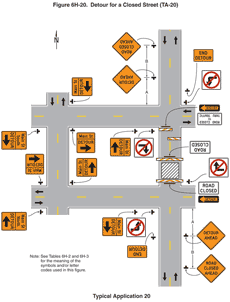
Notes for Figure 6H-21—Typical Application 21
Lane Closure on the Near Side of an Intersection
Standard:
- The merging taper shall direct vehicular traffic into either the right-hand or left-hand lane, but not both.
Guidance:
- In this typical application, a left taper should be used so that right-turn movements will not impede through motor vehicle traffic. However, the reverse should be true for left-turn movements.
- If the work space extends across a crosswalk, the crosswalk should be closed using the information and devices shown in Figure 6H-29.
Option:
- Flashing warning lights and/or flags may be used to call attention to the advance warning signs.
- A shadow vehicle with a truck-mounted attenuator may be used.
- A work vehicle with high-intensity rotating, flashing, oscillating, or strobe lights may be used with the high-level warning device.
- Vehicle hazard warning signals may be used to supplement high-intensity rotating, flashing, oscillating, or strobe lights.
Standard:
- Vehicle hazard warning signals shall not be used instead of the vehicle's high-intensity rotating, flashing, oscillating, or strobe lights.
Figure 6H-21 Lane Closure on the Near Side of an Intersection (TA-21)
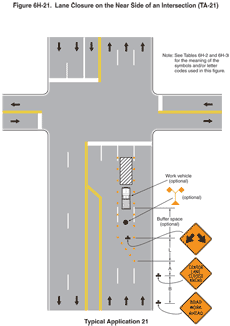
Notes for Figure 6H-22—Typical Application 22
Right-Hand Lane Closure on the Far Side of an Intersection
Guidance:
- If the work space extends across a crosswalk, the crosswalk should be closed using the information and devices shown in Figure 6H-29.
Option:
- The normal procedure is to close on the near side of the intersection any lane that is not carried through the intersection. However, when this results in the closure of a right-hand lane having significant right turning movements, then the right-hand lane may be restricted to right turns only, as shown. This procedure increases the through capacity by eliminating right turns from the open through lane.
- For intersection approaches reduced to a single lane, left-turning movements may be prohibited to maintain capacity for through vehicular traffic.
- Flashing warning lights and/or flags may be used to call attention to the advance warning signs.
- Where the turning radius is large, it may be possible to create a right-turn island using channelizing devices or pavement markings.
Figure 6H-22 Right-Hand Lane Closure on the Far Side of an Intersection (TA-22)
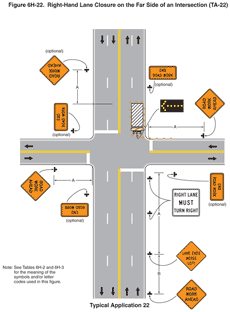
Notes for Figure 6H-23—Typical Application 23
Left-Hand Lane Closure on the Far Side of an Intersection
Guidance:
- If the work space extends across a crosswalk, the crosswalk should be closed using the information and devices shown in Figure 6H-29.
Option:
- Flashing warning lights and/or flags may be used to call attention to the advance warning signs.
- The normal procedure is to close on the near side of the intersection any lane that is not carried through the intersection. However, when this results in the closure of a left lane having significant left-turning movements, then the left lane may be reopened as a turn bay for left turns only, as shown.
Support:
- By first closing off the left lane and then reopening it as a turn bay, the left-turn bay allows storage of turning vehicles so that the movement of through traffic is not impeded. A left-turn bay that is long enough to accommodate all turning vehicles during a traffic signal cycle will provide the maximum benefit for through traffic. Also, an island is created with channelizing devices that allows the LEFT LANE MUST TURN LEFT sign to be repeated on the left adjacent to the lane that it controls.
Figure 6H-23 Left-Hand Lane Closure on the Far Side of an Intersection (TA-23)
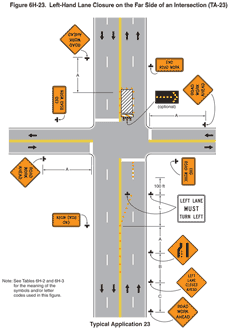
Notes for Figure 6H-24—Typical Application 24
Half Road Closure on the Far Side of an Intersection
Guidance:
- If the work space extends across a crosswalk, the crosswalk should be closed using the information and devices shown in Figure 6H-29.
- When turn prohibitions are implemented, two turn prohibition signs should be used, one on the near side and, space permitting, one on the far side of the intersection.
Option:
- A buffer space may be used between opposing directions of vehicular traffic as shown in this application.
- The normal procedure is to close on the near side of the intersection any lane that is not carried through the intersection. However, if there is a significant right-turning movement, then the right-hand lane may be restricted to right turns only, as shown.
- Where the turning radius is large, a right-turn island using channelizing devices or pavement markings may be used.
- There may be insufficient space to place the back-to-back Keep Right sign and No Left Turn symbol signs at the end of the row of channelizing devices separating opposing vehicular traffic flows. In this situation, the No Left Turn symbol sign may be placed on the right and the Keep Right sign may be omitted.
- For intersection approaches reduced to a single lane, left-turning movements may be prohibited to maintain capacity for through vehicular traffic.
- Flashing warning lights and/or flags may be used to call attention to advance warning signs.
- Temporary pavement markings may be used to delineate the travel path through the intersection.
Support:
- Keeping the right-hand lane open increases the through capacity by eliminating right turns from the open through lane.
- A temporary turn island reinforces the nature of the temporary exclusive right-turn lane and enables a second RIGHT LANE MUST TURN RIGHT sign to be placed in the island.
Figure 6H-24 Half Road Closure on the Far Side of an Intersection (TA-24)
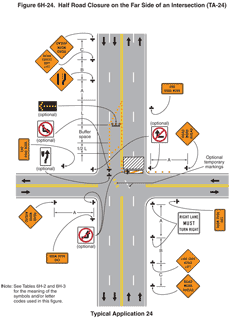
Notes for Figure 6H-25—Typical Application 25
Multiple Lane Closures at an Intersection
Guidance:
- If the work space extends across a crosswalk, the crosswalk should be closed using the information and devices shown in Figure 6H-29.
- If the left through lane is closed on the near-side approach, the LEFT LANE MUST TURN LEFT sign should be placed in the median to discourage through vehicular traffic from entering the left-turn bay.
Support:
- The normal procedure is to close on the near side of the intersection any lane that is not carried through the intersection.
Option:
- If the left-turning movement that normally uses the closed turn bay is small and/or the gaps in opposing vehicular traffic are frequent, left turns may be permitted on that approach.
- Flashing warning lights and/or flags may be used to call attention to the advance warning signs.
Figure 6H-25 Multiple Lane Closures at an Intersection (TA-25)
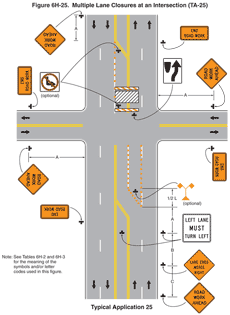
Notes for Figure 6H-26—Typical Application 26
Closure in the Center of an Intersection
Guidance:
- All lanes should be a minimum of 10 feet in width as measured to the near face of the channelizing devices.
Option:
- A high-level warning device may be placed in the work space, if there is sufficient room.
- For short-term use on low-volume, low-speed roadways with vehicular traffic that does not include longer and wider heavy commercial vehicles, a minimum lane width of 9 feet may be used.
- Flashing warning lights and/or flags may be used to call attention to advance warning signs.
- Unless the streets are wide, it may be physically impossible to turn left, especially for large vehicles. Left turns may be prohibited as required by geometric conditions.
- For short-duration work operations, the channelizing devices may be eliminated if a vehicle displaying high-intensity rotating, flashing, oscillating, or strobe lights is positioned in the work space.
- Vehicle hazard warning signals may be used to supplement high-intensity rotating, flashing, oscillating, or strobe lights.
Standard:
- Vehicle hazard warning signals shall not be used instead of the vehicle's high-intensity rotating, flashing, oscillating, or strobe lights.
Figure 6H-26 Closure in the Center of an Intersection (TA-26)
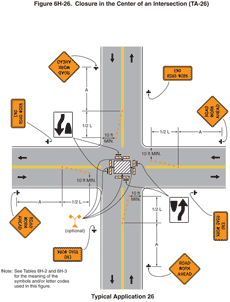
Notes for Figure 6H-27—Typical Application 27
Closure at the Side of an Intersection
Guidance:
- The situation depicted can be simplified by closing one or more of the intersection approaches. If this cannot be done, and/or when capacity is a problem, through vehicular traffic should be directed to other roads or streets.
- Depending on road user conditions, flagger(s) or uniformed law enforcement officer(s) should be used to direct road users within the intersection.
Standard:
- At night, flagger stations shall be illuminated, except in emergencies.
Option:
- Flashing warning lights and/or flags may be used to call attention to the advance warning signs.
- For short-duration work operations, the channelizing devices may be eliminated if a vehicle displaying high-intensity rotating, flashing, oscillating, or strobe lights is positioned in the work space.
- A BE PREPARED TO STOP sign may be added to the sign series.
Guidance:
- When used, the BE PREPARED TO STOP sign should be located before the Flagger symbol sign.
- ONE LANE ROAD AHEAD signs should also be used to provide adequate advance warning.
Support:
- Turns can be prohibited as required by vehicular traffic conditions. Unless the streets are wide, it might be physically impossible to make certain turns, especially for large vehicles.
Option:
- Vehicle hazard warning signals may be used to supplement high-intensity rotating, flashing, oscillating, or strobe lights.
Standard:
- Vehicle hazard warning signals shall not be used instead of the vehicle's high-intensity rotating, flashing, oscillating, or strobe lights.
Figure 6H-27 Closure at the Side of an Intersection (TA-27)
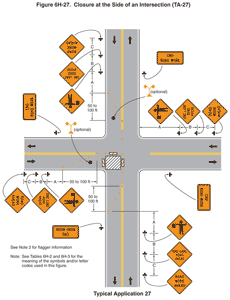
Notes for Figure 6H-28—Typical Application 28
Sidewalk Detour or Diversion
Standard:
- When crosswalks or other pedestrian facilities are closed or relocated, temporary facilities shall be detectable and shall include accessibility features consistent with the features present in the existing pedestrian facility.
Guidance:
- Where high speeds are anticipated, a temporary traffic barrier and, if necessary, a crash cushion should be used to separate the temporary sidewalks from vehicular traffic.
- Audible information devices should be considered where midblock closings and changed crosswalk areas cause inadequate communication to be provided to pedestrians who have visual disabilities.
Option:
- Street lighting may be considered.
- Only the TTC devices related to pedestrians are shown. Other devices, such as lane closure signing or ROAD NARROWS signs, may be used to control vehicular traffic.
- For nighttime closures, Type A Flashing warning lights may be used on barricades that support signs and close sidewalks.
- Type C Steady-Burn or Type D 360-degree Steady-Burn warning lights may be used on channelizing devices separating the temporary sidewalks from vehicular traffic flow.
- Signs, such as KEEP RIGHT (LEFT), may be placed along a temporary sidewalk to guide or direct pedestrians.
Figure 6H-28 Sidewalk Detour or Diversion (TA-28)
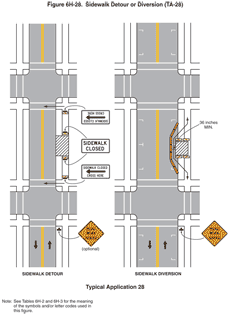
Notes for Figure 6H-29—Typical Application 29
Crosswalk Closures and Pedestrian Detours
Standard:
- When crosswalks or other pedestrian facilities are closed or relocated, temporary facilities shall be detectable and shall include accessibility features consistent with the features present in the existing pedestrian facility.
- Curb parking shall be prohibited for at least 50 feet in advance of the midblock crosswalk.
Guidance:
- Audible information devices should be considered where midblock closings and changed crosswalk areas cause inadequate communication to be provided to pedestrians who have visual disabilities.
- Pedestrian traffic signal displays controlling closed crosswalks should be covered or deactivated.
Option:
- Street lighting may be considered.
- Only the TTC devices related to pedestrians are shown. Other devices, such as lane closure signing or ROAD NARROWS signs, may be used to control vehicular traffic.
- For nighttime closures, Type A Flashing warning lights may be used on barricades supporting signs and closing sidewalks.
- Type C Steady-Burn or Type D 360-degree Steady-Burn warning lights may be used on channelizing devices separating the work space from vehicular traffic.
- In order to maintain the systematic use of the fluorescent yellow-green background for pedestrian, bicycle, and school warning signs in a jurisdiction, the fluorescent yellow-green background for pedestrian, bicycle, and school warning signs may be used in TTC zones.
Figure 6H-29 Crosswalk Closures and Pedestrian Detours (TA-29)
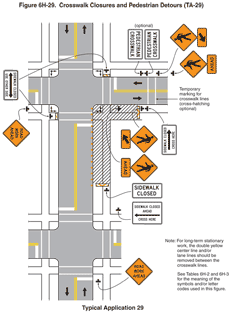
Notes for Figure 6H-30—Typical Application 30
Interior Lane Closure on a Multi-Lane Street
Guidance:
- This information applies to low-speed, low-volume urban streets. Where speed or volume is higher, additional signing such as LEFT LANE CLOSED XX FT should be used between the signs shown.
Option:
- The closure of the adjacent interior lane in the opposing direction may not be necessary, depending upon the activity being performed and the work space needed for the operation.
- Shadow vehicles with a truck-mounted attenuator may be used.
Figure 6H-30 Interior Lane Closure on a Multi-Lane Street (TA-30)
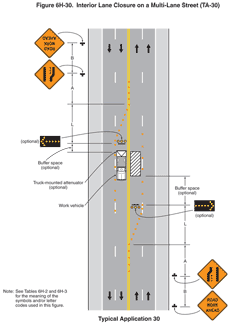
Notes for Figure 6H-31—Typical Application 31
Lane Closures on a Street with Uneven Directional Volumes
Standard:
- The illustrated information shall be used only when the vehicular traffic volume indicates that two lanes of vehicular traffic shall be maintained in the direction of travel for which one lane is closed.
Option:
- The procedure may be used during a peak period of vehicular traffic and then changed to provide two lanes in the other direction for the other peak.
Guidance:
- For high speeds, a LEFT LANE CLOSED XX FT sign should be added for vehicular traffic approaching the lane closure, as shown in Figure 6H-32.
- Conflicting pavement markings should be removed for long-term projects. For short-term and intermediate-term projects where this is not practical, the channelizing devices in the area where the pavement markings conflict should be placed at a maximum spacing of 1/2 S feet where S is the speed in mph. Temporary markings should be installed where needed.
- If the lane shift has curves with recommended speeds of 30 mph or less, Reverse Turn signs should be used.
- Where the shifted section is long, a Reverse Curve sign should be used to show the initial shift and a second sign should be used to show the return to the normal alignment.
- If the tangent distance along the temporary diversion is less than 600 feet, the Double Reverse Curve sign should be used at the location of the first Two Lane Reverse Curve sign. The second Two Lane Reverse Curve sign should be omitted.
Standard:
- The number of lanes illustrated on the Reverse Curve or Double Reverse Curve signs shall be the same as the number of through lanes available to road users, and the direction of the reverse curves shall be appropriately illustrated.
Option:
- A longitudinal buffer space may be used in the activity area to separate opposing vehicular traffic.
- Where two or more lanes are being shifted, a W1-4 (or W1-3) sign with an ALL LANES (W24-1cP) plaque (see Figure 6F-4) may be used instead of a sign that illustrates the number of lanes.
- Where more than three lanes are being shifted, the Reverse Curve (or Turn) sign may be rectangular.
- A work vehicle or a shadow vehicle may be equipped with a truck-mounted attenuator.
Figure 6H-31 Lane Closures on a Street with Uneven Directional Volumes (TA-31)
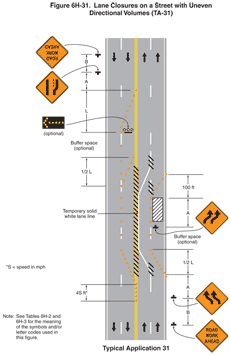
Notes for Figure 6H-32—Typical Application 32
Half Road Closure on a Multi-Lane, High-Speed Highway
Standard:
- Pavement markings no longer applicable shall be removed or obliterated as soon as practical. Except for intermediate-term and short-term situations, temporary markings shall be provided to clearly delineate the temporary travel path. For short-term and intermediate-term situations where it is not feasible to remove and restore pavement markings, channelization shall be made dominant by using a very close device spacing.
Guidance:
- When paved shoulders having a width of 8 feet or more are closed, channelizing devices should be used to close the shoulder in advance of the merging taper to direct vehicular traffic to remain within the traveled way.
- Where channelizing devices are used instead of pavement markings, the maximum spacing should be 1/2 S feet where S is the speed in mph.
- If the tangent distance along the temporary diversion is less than 600 feet, a Double Reverse Curve sign should be used instead of the first Reverse Curve sign, and the second Reverse Curve sign should be omitted.
Option:
- Warning lights may be used to supplement channelizing devices at night.
- A truck-mounted attenuator may be used on the work vehicle and/or the shadow vehicle.
Figure 6H-32 Half Road Closure on a Multi-Lane, High-Speed Highway (TA-32)
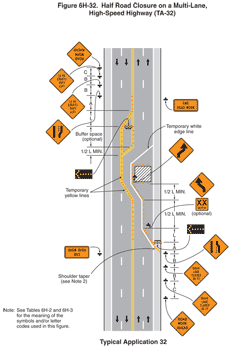
Notes for Figure 6H-33—Typical Application 33
Stationary Lane Closure on a Divided Highway
Standard:
- This information also shall be used when work is being performed in the lane adjacent to the median on a divided highway. In this case, the LEFT LANE CLOSED signs and the corresponding Lane Ends signs shall be substituted.
- When a side road intersects the highway within the TTC zone, additional TTC devices shall be placed as needed.
Guidance:
- When paved shoulders having a width of 8 feet or more are closed, channelizing devices should be used to close the shoulder in advance of the merging taper to direct vehicular traffic to remain within the traveled way.
Option:
- A truck-mounted attenuator may be used on the work vehicle and/or shadow vehicle.
Support:
- Where conditions permit, restricting all vehicles, equipment, workers, and their activities to one side of the roadway might be advantageous.
Standard:
- An arrow board shall be used when a freeway lane is closed. When more than one freeway lane is closed, a separate arrow board shall be used for each closed lane.
Figure 6H-33 Stationary Lane Closure on a Divided Highway (TA-33)
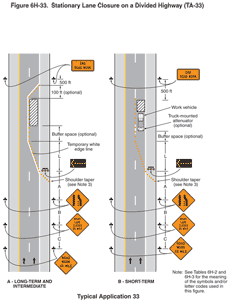
Notes for Figure 6H-34—Typical Application 34
Lane Closure with a Temporary Traffic Barrier
Standard:
- This information also shall be used when work is being performed in the lane adjacent to the median on a divided highway. In this case, the LEFT LANE CLOSED signs and the corresponding Lane Ends signs shall be substituted.
Guidance:
- For long-term lane closures on facilities with permanent edge lines, a temporary edge line should be installed from the upstream end of the merging taper to the downstream end of the downstream taper, and conflicting pavement markings should be removed.
- The use of a barrier should be based on engineering judgment.
Standard:
- Temporary traffic barriers, if used, shall comply with the provisions of Section 6F.85.
- The barrier shall not be placed along the merging taper. The lane shall first be closed using channelizing devices and pavement markings.
Option:
- Type C Steady-Burn warning lights may be placed on channelizing devices and the barrier parallel to the edge of pavement for nighttime lane closures.
- The barrier shown in this typical application is an example of one method that may be used to close a lane for a long-term project. If the work activity permits, a movable barrier may be used and relocated to the shoulder during non-work periods or peak-period vehicular traffic conditions, as appropriate.
Standard:
- If a movable barrier is used, the temporary white edge line shown in the typical application shall not be used. During the period when the right-hand lane is opened, the sign legends and the channelization shall be changed to indicate that only the shoulder is closed, as illustrated in Figure 6H-5. The arrow board, if used, shall be placed at the downstream end of the shoulder taper and shall display the caution mode.
Guidance:
- If a movable barrier is used, the shift should be performed in the following manner. When closing the lane, the lane should be initially closed with channelizing devices placed along a merging taper using the same information employed for a stationary lane closure. The lane closure should then be extended with the movable-barrier transfer vehicle moving with vehicular traffic. When opening the lane, the movable-barrier transfer vehicle should travel against vehicular traffic from the termination area to the transition area. The merging taper should then be removed using the same information employed for a stationary lane closure.
Figure 6H-34 Lane Closure with a Temporary Traffic Barrier (TA-34)
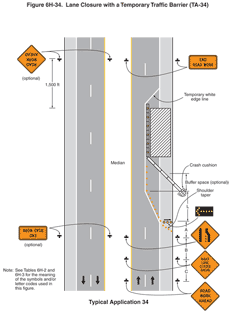
Notes for Figure 6H-35—Typical Application 35
Mobile Operation on a Multi-Lane Road
Standard:
- Arrow boards shall, as a minimum, be Type B, with a size of 60 x 30 inches.
- Vehicle-mounted signs shall be mounted in a manner such that they are not obscured by equipment or supplies. Sign legends on vehicle-mounted signs shall be covered or turned from view when work is not in progress.
- Shadow and work vehicles shall display high-intensity rotating, flashing, oscillating, or strobe lights.
- An arrow board shall be used when a freeway lane is closed. When more than one freeway lane is closed, a separate arrow board shall be used for each closed lane.
Guidance:
- Vehicles used for these operations should be made highly visible with appropriate equipment, such as flags, signs, or arrow boards.
- Shadow Vehicle 1 should be equipped with an arrow board and truck-mounted attenuator.
- Shadow Vehicle 2 should be equipped with an arrow board. An appropriate lane closure sign should be placed on Shadow Vehicle 2 so as not to obscure the arrow board.
- Shadow Vehicle 2 should travel at a varying distance from the work operation so as to provide adequate sight distance for vehicular traffic approaching from the rear.
- The spacing between the work vehicles and the shadow vehicles, and between each shadow vehicle should be minimized to deter road users from driving in between.
- Work should normally be accomplished during off-peak hours.
- When the work vehicle occupies an interior lane (a lane other than the far right or far left) of a directional roadway having a right-hand shoulder 10 feet or more in width, Shadow Vehicle 2 should drive the right-hand shoulder with a sign indicating that work is taking place in the interior lane.
Option:
- A truck-mounted attenuator may be used on Shadow Vehicle 2.
- On high-speed roadways, a third shadow vehicle (not shown) may be used with Shadow Vehicle 1 in the closed lane, Shadow Vehicle 2 straddling the edge line, and Shadow Vehicle 3 on the shoulder.
- Where adequate shoulder width is not available, Shadow Vehicle 3 may also straddle the edge line.
Figure 6H-35 Mobile Operation on a Multi-Lane Road (TA-35)
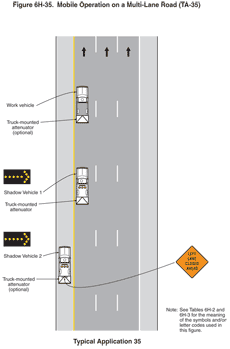
Notes for Figure 6H-36—Typical Application 36
Lane Shift on a Freeway
Guidance:
- The lane shift should be used when the work space extends into either the right-hand or left-hand lane of a divided highway and it is not practical, for capacity reasons, to reduce the number of available lanes.
Support:
- When a lane shift is accomplished by using (1) geometry that meets the design speed at which the permanent highway was designed, (2) full normal cross-section (full lane width and full shoulders), and (3) complete pavement markings, then only the initial general work-zone warning sign is required.
Guidance:
- When the conditions in Note 2 are not met, the information shown in the typical application should be employed and all the following notes apply.
Standard:
- Temporary traffic barriers, if used, shall comply with the provisions of Section 6F.85.
- The barrier shall not be placed along the shifting taper. The lane shall first be shifted using channelizing devices and pavement markings.
Guidance:
- A warning sign should be used to show the changed alignment.
Standard:
- The number of lanes illustrated on the Reverse Curve signs shall be the same as the number of through lanes available to road users, and the direction of the reverse curves shall be appropriately illustrated.
Option:
- Where two or more lanes are being shifted, a W1-4 (or W1-3) sign with an ALL LANES (W24-1cP) plaque (see Figure 6F-4) may be used instead of a sign that illustrates the number of lanes.
- Where more than three lanes are being shifted, the Reverse Curve (or Turn) sign may be rectangular.
Guidance:
- Where the shifted section is longer than 600 feet, one set of Reverse Curve signs should be used to show the initial shift and a second set should be used to show the return to the normal alignment. If the tangent distance along the temporary diversion is less than 600 feet, a Double Reverse Curve sign should be used instead of the first Reverse Curve sign, and the second Reverse Curve sign should be omitted.
- If a STAY IN LANE sign is used, then solid white lane lines should be used.
Standard:
- The minimum width of the shoulder lane shall be 10 feet.
- For long-term stationary work, existing conflicting pavement markings shall be removed and temporary markings shall be installed before traffic patterns are changed.
Option:
- For short-term stationary work, lanes may be delineated by channelizing devices or removable pavement markings instead of temporary markings.
Guidance:
- If the shoulder cannot adequately accommodate trucks, trucks should be directed to use the travel lanes.
- The use of a barrier should be based on engineering judgment.
Option:
- Type C Steady-Burn warning lights may be placed on channelizing devices and the barrier parallel to the edge of the pavement for nighttime lane closures.
Figure 6H-36 Lane Shift on a Freeway (TA-36)
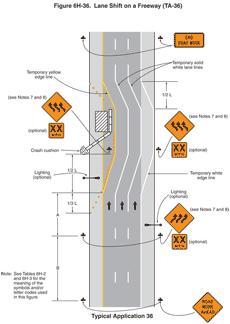
Notes for Figure 6H-37—Typical Application 37
Double Lane Closure on a Freeway
Standard:
- An arrow board shall be used when a freeway lane is closed. When more than one freeway lane is closed, a separate arrow board shall be used for each closed lane.
Guidance:
- Ordinarily, the preferred position for the second arrow board is in the closed exterior lane at the upstream end of the second merging taper. However, the second arrow board should be placed in the closed interior lane at the downstream end of the second merging taper in the following situations:
- When a shadow vehicle is used in the interior closed lane, and the second arrow board is mounted on the shadow vehicle;
- If alignment or other conditions create any confusion as to which lane is closed by the second arrow board; and
- When the first arrow board is placed in the closed exterior lane at the downstream end of the first merging taper (the alternative position when the shoulder is narrow).
Option:
- Flashing warning lights and/or flags may be used to call attention to the initial warning signs.
- A truck-mounted attenuator may be used on the shadow vehicle.
- If a paved shoulder having a minimum width of 10 feet and sufficient strength is available, the left and adjacent interior lanes may be closed and vehicular traffic carried around the work space on the right-hand lane and a right-hand shoulder.
Guidance:
- When a shoulder lane is used that cannot adequately accommodate trucks, trucks should be directed to use the normal travel lanes.
Figure 6H-37 Double Lane Closure on a Freeway (TA-37)
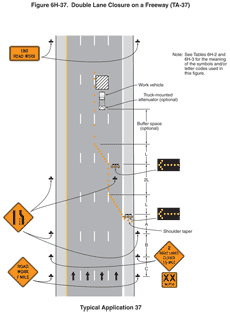
Notes for Figure 6H-38—Typical Application 38
Interior Lane Closure on a Freeway
Standard:
- An arrow board shall be used when a freeway lane is closed. When more than one freeway lane is closed, a separate arrow board shall be used for each closed lane.
- If temporary traffic barriers are installed, they shall comply with the provisions and requirements in Section 6F.85.
- The barrier shall not be placed along the shifting taper. The lane shall first be shifted using channelizing devices and pavement markings.
- For long-term stationary work, existing conflicting pavement markings shall be removed and temporary markings shall be installed before traffic patterns are changed.
Guidance:
- For a long-term closure, a barrier should be used to provide additional safety to the operation in the closed interior lane. A buffer space should be used at the upstream end of the closed interior lane.
- The first arrow board displaying an arrow pointing to the right should be on the left-hand shoulder at the beginning of the taper. The arrow board displaying a double arrow should be centered in the closed interior lane and placed at the downstream end of the shifting taper.
- If the two arrow boards create confusion, the 2L distance between the end of the merging taper and beginning of the shift taper should be extended so that road users can focus on one arrow board at a time.
- The placement of signs should not obstruct or obscure arrow boards.
- For long-term use, the dashed lane lines should be made solid white in the two-lane section.
Option:
- As an alternative to initially closing the left-hand lane, as shown in the typical application, the right-hand lane may be closed in advance of the interior lane closure with appropriate channelization and signs.
- A short, single row of channelizing devices in advance of the vehicular traffic split to restrict vehicular traffic to their respective lanes may be added.
- DO NOT PASS signs may be used.
- If a paved shoulder having a minimum width of 10 feet and sufficient strength is available, the left-hand and center lanes may be closed and motor vehicle traffic carried around the work space on the right-hand lane and a right-hand shoulder.
Guidance:
- When a shoulder lane is used that cannot adequately accommodate trucks, trucks should be directed to use the normal travel lanes.
Figure 6H-38 Interior Lane Closure on a Freeway (TA-38)
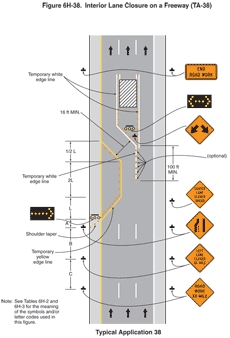
Notes for Figure 6H-39—Typical Application 39
Median Crossover on a Freeway
Standard:
- Channelizing devices or temporary traffic barriers shall be used to separate opposing vehicular traffic.
- An arrow board shall be used when a freeway lane is closed. When more than one freeway lane is closed, a separate arrow board shall be used for each closed lane.
Guidance:
- For long-term work on high-speed, high-volume highways, consideration should be given to using a temporary traffic barrier to separate opposing vehicular traffic.
Option:
- When a temporary traffic barrier is used to separate opposing vehicular traffic, the Two-Way Traffic, Do Not Pass, KEEP RIGHT, and DO NOT ENTER signs may be eliminated.
- The alignment of the crossover may be designed as a reverse curve.
Guidance:
- When the crossover follows a curved alignment, the design criteria contained in the AASHTO "Policy on the Geometric Design of Highways and Streets" (see Section 1A.11) should be used.
- When channelizing devices have the potential of leading vehicular traffic out of the intended traffic space, the channelizing devices should be extended a distance in feet of 2.0 times the speed limit in mph beyond the downstream end of the transition area as depicted.
- Where channelizing devices are used, the Two-Way Traffic signs should be repeated every 1 mile.
Option:
- NEXT XX MILES Supplemental Distance plaques may be used with the Two-Way Traffic signs, where XX is the distance to the downstream end of the two-way section.
Support:
- When the distance is sufficiently short that road users entering the section can see the downstream end of the section, they are less likely to forget that there is opposing vehicular traffic.
- The sign legends for the four pairs of signs approaching the lane closure for the non-crossover direction of travel are not shown. They are similar to the series shown for the crossover direction, except that the left lane is closed.
Figure 6H-39 Median Crossover on a Freeway (TA-39)
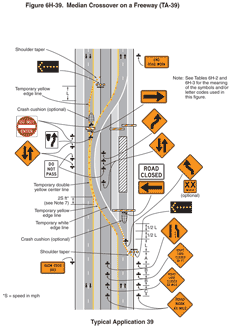
Notes for Figure 6H-40—Typical Application 40
Median Crossover for an Entrance Ramp
Guidance:
- The typical application illustrated should be used for carrying an entrance ramp across a closed directional roadway of a divided highway.
- A temporary acceleration lane should be used to facilitate merging.
- When used, the YIELD or STOP sign should be located far enough forward to provide adequate sight distance of oncoming mainline vehicular traffic to select an acceptable gap, but should not be located so far forward that motorists will be encouraged to stop in the path of the mainline traffic. If needed, yield or stop lines should be installed across the ramp to indicate the point at which road users should yield or stop. Also, a longer acceleration lane should be provided beyond the sign to reduce the gap size needed.
Option:
- If vehicular traffic conditions allow, the ramp may be closed.
- A broken edge line may be carried across the temporary entrance ramp to assist in defining the through vehicular traffic lane.
- When a temporary traffic barrier is used to separate opposing vehicular traffic, the Two-Way Traffic signs and the DO NOT ENTER signs may be eliminated.
Figure 6H-40 Median Crossover for an Entrance Ramp (TA-40)
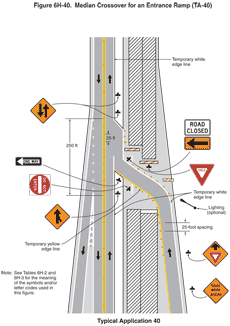
Notes for Figure 6H-41—Typical Application 41
Median Crossover for an Exit Ramp
Guidance:
- This typical application should be used for carrying an exit ramp across a closed directional roadway of a divided highway. The design criteria contained in the AASHTO "Policy on the Geometric Design of Highways and Streets" (see Section 1A.11) should be used for determining the curved alignment.
- The guide signs should indicate that the ramp is open, and where the temporary ramp is located. Conversely, if the ramp is closed, guide signs should indicate that the ramp is closed.
- When the exit is closed, a black on orange EXIT CLOSED sign panel should be placed diagonally across the interchange/intersection guide signsand channelizing devices should be placed to physically close the ramp.
- In the situation (not shown) where channelizing devices are placed along the mainline roadway, the devices' spacing should be reduced in the vicinity of the off ramp to emphasize the opening at the ramp itself. Channelizing devices and/or temporary pavement markings should be placed on both sides of the temporary ramp where it crosses the median and the closed roadway.
- Advance guide signs providing information related to the temporary exit should be relocated or duplicated adjacent to the temporary roadway.
Standard:
- A temporary EXIT sign shall be located in the temporary gore. For better visibility, it shall be mounted a minimum of 7 feet from the pavement surface to the bottom of the sign.
Option:
- Guide signs referring to the exit may need to be relocated to the median.
- The temporary EXIT sign placed in the temporary gore may be either black on orange or white on green.
- In some instances, a temporary deceleration lane may be useful in facilitating the exiting maneuver.
- When a temporary traffic barrier is used to separate opposing vehicular traffic, the Two-Way Traffic signs may be omitted.
Figure 6H-41 Median Crossover for an Exit Ramp (TA-41)
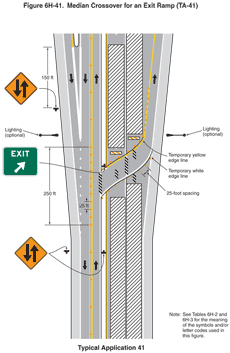
Notes for Figure 6H-42—Typical Application 42
Work in the Vicinity of an Exit Ramp
Guidance:
- The guide signs should indicate that the ramp is open, and where the temporary ramp is located. However, if the ramp is closed, guide signs should indicate that the ramp is closed.
- When the exit ramp is closed, a black on orange EXIT CLOSED sign panel should be placed diagonally across the interchange/intersection guide signs.
- The design criteria contained in the AASHTO "Policy on the Geometric Design of Highways and Streets" (see Section 1A.11) should be used for determining the alignment.
Standard:
- A temporary EXIT sign shall be located in the temporary gore. For better visibility, it shall be mounted a minimum of 7 feet from the pavement surface to the bottom of the sign.
Option:
- The temporary EXIT sign placed in the temporary gore may be either black on orange or white on green.
- An alternative procedure that may be used is to channelize exiting vehicular traffic onto the right-hand shoulder and close the lane as necessary.
Standard:
- An arrow board shall be used when a freeway lane is closed. When more than one freeway lane is closed, a separate arrow board shall be used for each closed lane.
Figure 6H-42 Work in the Vicinity of an Exit Ramp (TA-42)
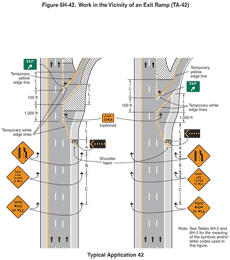
Notes for Figure 6H-43—Typical Application 43
Partial Exit Ramp Closure
Guidance:
- Truck off-tracking should be considered when determining whether the minimum lane width of 10 feet is adequate (see Section 6G.08).
Figure 6H-43 Partial Exit Ramp Closure (TA-43)
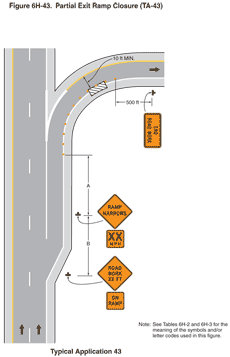
Notes for Figure 6H-44—Typical Application 44
Work in the Vicinity of an Entrance Ramp
Guidance:
- An acceleration lane of sufficient length should be provided whenever possible as shown on the left diagram.
Standard:
- For the information shown on the diagram on the right-hand side of the typical application, where inadequate acceleration distance exists for the temporary entrance, the YIELD sign shall be replaced with STOP signs (one on each side of the approach).
Guidance:
- When used, the YIELD or STOP sign should be located so that ramp vehicular traffic has adequate sight distance of oncoming mainline vehicular traffic to select an acceptable gap in the mainline vehicular traffic flow, but should not be located so far forward that motorists will be encouraged to stop in the path of the mainline traffic. Also, a longer acceleration lane should be provided beyond the sign to reduce the gap size needed. If insufficient gaps are available, consideration should be given to closing the ramp.
- Where STOP signs are used, a temporary stop line should be placed across the ramp at the desired stop location.
- The mainline merging taper with the arrow board at its starting point should be located sufficiently in advance so that the arrow board is not confusing to drivers on the entrance ramp, and so that the mainline merging vehicular traffic from the lane closure has the opportunity to stabilize before encountering the vehicular traffic merging from the ramp.
- If the ramp curves sharply to the right, warning signs with advisory speeds located in advance of the entrance terminal should be placed in pairs (one on each side of the ramp).
Option:
- A Stop Beacon (see Section 4L.05) or a Type B high-intensity warning flasher with a red lens may be placed above the STOP sign.
- Where the acceleration distance is significantly reduced, a supplemental plaque may be placed below the Yield Ahead sign reading NO MERGE AREA.
Standard:
- An arrow board shall be used when a freeway lane is closed. When more than one freeway lane is closed, a separate arrow board shall be used for each closed lane.
Figure 6H-44 Work in the Vicinity of an Entrance Ramp (TA-44)
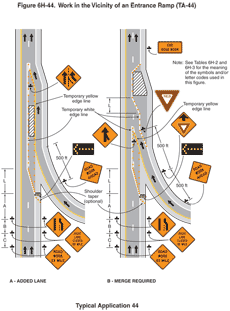
Notes for Figure 6H-45—Typical Application 45
Temporary Reversible Lane Using Movable Barriers
Support:
- This application addresses one of several uses for movable barriers (see Section 6F.85) in highway work zones. In this example, one side of a 6-lane divided highway is closed to perform the work operation, and vehicular traffic is carried in both directions on the remaining 3-lane roadway by means of a median crossover.
To accommodate unbalanced peak-period vehicular traffic volumes, the direction of travel in the center lane is switched to the direction having the greater volume, with the transfer typically being made twice daily. Thus, there are four vehicular traffic phases described as follows:- Phase A-two travel lanes northbound and one lane southbound;
- Transition A to B-one travel lane in each direction;
- Phase B-one travel lane northbound and two lanes southbound; and
- Transition B to A-one travel lane in each direction.
The typical application on the left illustrates the placement of devices during Phase A. The typical application on the right shows conditions during the transition (Transition A to B) from Phase A to Phase B.
Guidance:
- For the reversible-lane situation depicted, the ends of the movable barrier should terminate in a protected area or a crash cushion should be provided. During Phase A, the transfer vehicle should be parked behind the downstream end of the movable barrier for southbound traffic as shown in the typical application on the left. During Phase B, the transfer vehicle should be parked behind between the downstream ends of the movable barriers at the north end of the TTC zone as shown in the typical application on the right.
The transition shift from Phase A to B should be as follows:- Change the signs in the northbound advance warning area and transition area from a LEFT LANE CLOSED AHEAD to a 2 LEFT LANES CLOSED AHEAD. Change the mode of the second northbound arrow board from Caution to Right Arrow.
- Place channelizing devices to close the northbound center lane.
- Move the transfer vehicle from south to north to shift the movable barrier from the west side to the east side of the reversible lane.
- Remove the channelizing devices closing the southbound center lane.
- Change the signs in the southbound transition area and advance warning area from a 2 LEFT LANES CLOSED AHEAD to a LEFT LANE CLOSED AHEAD. Change the mode of the second southbound arrow board from Right Arrow to Caution.
- Where the lane to be opened and closed is an exterior lane (adjacent to the edge of the traveled way or the work space), the lane closure should begin by closing the lane with channelizing devices placed along a merging taper using the same information employed for a stationary lane closure. The lane closure should then be extended with the movable-barrier transfer vehicle moving with vehicular traffic. When opening the lane, the transfer vehicle should travel against vehicular traffic. The merging taper should be removed in a method similar to a stationary lane closure.
Option:
- The procedure may be used during a peak period of vehicular traffic and then changed to provide two lanes in the other direction for the other peak.
- A longitudinal buffer space may be used in the activity area to separate opposing vehicular traffic.
- A work vehicle or a shadow vehicle may be equipped with a truck-mounted attenuator.
Standard:
- An arrow board shall be used when a freeway lane is closed. When more than one freeway lane is closed, a separate arrow board shall be used for each closed lane.
Figure 6H-45 Temporary Reversible Lane Using Movable Barriers (TA-45)
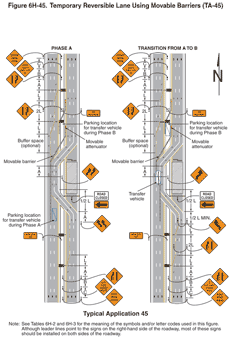
Notes for Figure 6H-46—Typical Application 46
Work in the Vicinity of a Grade Crossing
Guidance:
- When grade crossings exist either within or in the vicinity of roadway work activities, extra care should be taken to minimize the probability of conditions being created, by lane restrictions, flagging, or other operations, where vehicles might be stopped within the grade crossing, considered as being 15 feet on either side of the closest and farthest rail.
Standard:
- If the queuing of vehicles across active rail tracks cannot be avoided, a uniformed law enforcement officer or flagger shall be provided at the grade crossing to prevent vehicles from stopping within the grade crossing (as described in Note 1), even if automatic warning devices are in place.
Guidance:
- Early coordination with the railroad company or light rail transit agency should occur before work starts.
- In the example depicted, the buffer space of the activity area should be extended upstream of the grade crossing (as shown) so that a queue created by the flagging operation will not extend across the grade crossing.
- The DO NOT STOP ON TRACKS sign should be used on all approaches to a grade crossing within the limits of a TTC zone.
Option:
- Flashing warning lights and/or flags may be used to call attention to the advance warning signs.
- A BE PREPARED TO STOP sign may be added to the sign series.
Guidance:
- When used, the BE PREPARED TO STOP sign should be located before the Flagger symbol sign.
Standard:
- At night, flagger stations shall be illuminated, except in emergencies.
Figure 6H-46 Work in the Vicinity of a Grade Crossing (TA-46)
